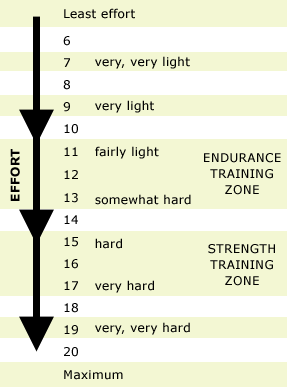Heart Rate (note: if you have heart or other medical problems, get a doctors OK before doing this)
Heart rate is the old standard. A simple way to judge is to count your pulse during exercise. You can do this in one of two common ways. One is on the thumb side of your wrist using the fingers of the opposite hand. (left)
The other is on your carotid artery (my preferred site, picture on below) Don't push too hard on your neck artery; it supplies your brain! You could pass out if you do.
(Google images pictures)
Found your pulse? Count for one minute. Or, if you are like me, I count for 10 seconds and multiply by 6. Then I can get back to working out. Personally I aim for about 150, so for 10 seconds I should count 25 beats. If my count is lower and I need to work harder. Much higher and I may be working out too hard for cardiovascular benefits and fat loss. I also may fatigue too soon if I start exercising anaerobically. (topic for future blog!)
How fast should your heart rate be? Check out the Mayo Clinic Calculator for it:
http://www.mayoclinic.com/health/target-heart-rate/SM00083
Perceived Exertion
The other method, somewhat simpler is to use perceived exertion. The rule of thumb is that you can feel your heart rate is elevated and you are working hard, but you can still talk to a friend or your dog or the bushes. If you can't you are breathing too hard and your heart rate is probably too high unless you are seeking to make strength gains, not cardiovascular gains. (Ask me about this if you want more info.) Back off a little bit. If you are not breathing hard at all, however, you need to step it up a bit to get the heart and fitness benefits. Stay in the 11-13 range on a scale of 1-20.

Source of image:
http://www.google.com/imgres?imgurl=http://www.thedoctorwillseeyounow.com/images/articles/senior/exertion.gif&imgrefurl=http://www.thedoctorwillseeyounow.com/content/aging/art2070.html%3FgetPage%3D3&h=387&w=287&sz=7&tbnid=ql2Qv7znfxL4FM:&tbnh=123&tbnw=91&prev=/images%3Fq%3Dperceived%2Bexertion%2Bscale&zoom=1&q=perceived+exertion+scale&hl=en&usg=__U2xccbCAaEW5EY29BioNlxMvMJI=&sa=X&ei=bUVUTcfbHcqEtgfe1PGtCQ&sqi=2&ved=0CD4Q9QEwCA
Questions? Let me know! Happy exercising-------